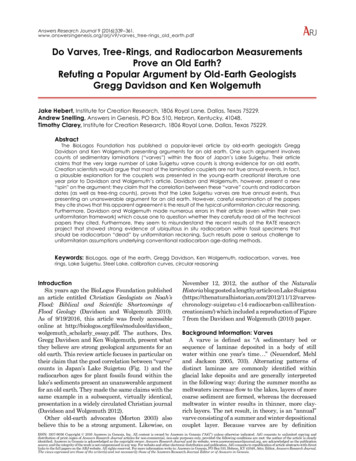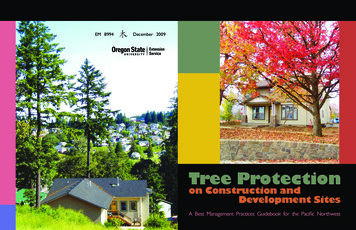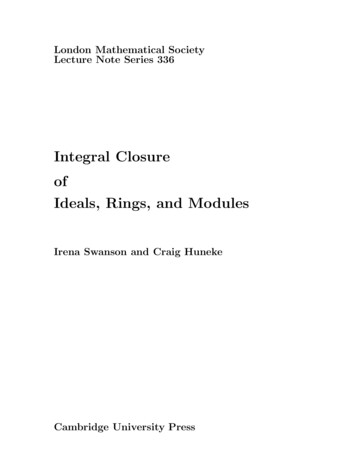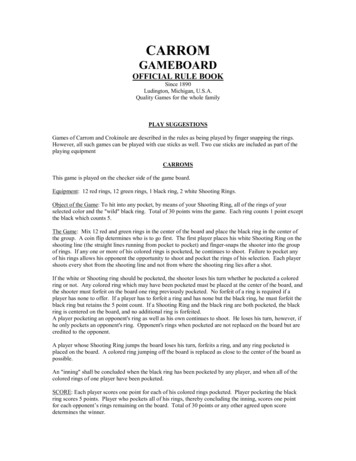
Transcription
Answers Research Journal 9 arves tree-rings old earth.pdfDo Varves, Tree-Rings, and Radiocarbon MeasurementsProve an Old Earth?Refuting a Popular Argument by Old-Earth GeologistsGregg Davidson and Ken WolgemuthJake Hebert, Institute for Creation Research, 1806 Royal Lane, Dallas, Texas 75229.Andrew Snelling, Answers in Genesis, PO Box 510, Hebron, Kentucky, 41048.Timothy Clarey, Institute for Creation Research, 1806 Royal Lane, Dallas, Texas 75229.AbstractThe BioLogos Foundation has published a popular-level article by old-earth geologists GreggDavidson and Ken Wolgemuth presenting arguments for an old earth. One such argument involvescounts of sedimentary laminations (“varves”) within the floor of Japan’s Lake Suigetsu. Their articleclaims that the very large number of Lake Suigetsu varve counts is strong evidence for an old earth.Creation scientists would argue that most of the lamination couplets are not true annual events. In fact,a plausible explanation for the couplets was presented in the young-earth creationist literature oneyear prior to Davidson and Wolgemuth’s article. Davidson and Wolgemuth, however, present a new“spin” on the argument: they claim that the correlation between these “varve” counts and radiocarbondates (as well as tree-ring counts), proves that the Lake Suigetsu varves are true annual events, thuspresenting an unanswerable argument for an old earth. However, careful examination of the papersthey cite shows that this apparent agreement is the result of the typical uniformitarian circular reasoning.Furthermore, Davidson and Wolgemuth made numerous errors in their article (even within their ownuniformitarian framework) which cause one to question whether they carefully read all of the technicalpapers they cited. Furthermore, they seem to misunderstand the recent results of the RATE researchproject that showed strong evidence of ubiquitous in situ radiocarbon within fossil specimens thatshould be radiocarbon “dead” by uniformitarian reckoning. Such results pose a serious challenge touniformitarian assumptions underlying conventional radiocarbon age-dating methods.Keywords: BioLogos, age of the earth, Gregg Davidson, Ken Wolgemuth, radiocarbon, varves, treerings, Lake Suigetsu, Steel Lake, calibration curves, circular reasoningIntroductionSix years ago the BioLogos Foundation publishedan article entitled Christian Geologists on Noah’sFlood: Biblical and Scientific Shortcomings ofFlood Geology (Davidson and Wolgemuth 2010).As of 9/19/2016, this article was freely accessibleonline at h scholarly essay.pdf. The authors, Drs.Gregg Davidson and Ken Wolgemuth, present whatthey believe are strong geological arguments for anold earth. This review article focuses in particular ontheir claim that the good correlation between “varve”counts in Japan’s Lake Suigetsu (Fig. 1) and theradiocarbon ages for plant fossils found within thelake’s sediments present an unanswerable argumentfor an old earth. They made the same claims with thesame example in a subsequent, virtually identical,presentation in a widely circulated Christian journal(Davidson and Wolgemuth 2012).Other old-earth advocates (Morton 2003) alsobelieve this to be a strong argument. Likewise, onNovember 12, 2012, the author of the NaturalisHistoria blog posted a lengthy article on Lake rationcreationism/) which included a reproduction of Figure7 from the Davidson and Wolgemuth (2010) paper.Background Information: VarvesA varve is defined as “A sedimentary bed orsequence of laminae deposited in a body of stillwater within one year’s time . . .” (Neuendorf, Mehland Jackson 2005, 703). Alternating patterns ofdistinct laminae are commonly identified withinglacial lake deposits and are generally interpretedin the following way: during the summer months asmeltwaters increase flow to the lakes, layers of morecoarse sediment are formed, whereas the decreasedmeltwater in winter results in thinner, more clayrich layers. The net result, in theory, is an “annual”varve consisting of a summer and winter depositionalcouplet layer. Because varves are by definitionISSN: 1937-9056 Copyright 2016 Answers in Genesis, Inc. All content is owned by Answers in Genesis (“AiG”) unless otherwise indicated. AiG consents to unlimited copying anddistribution of print copies of Answers Research Journal articles for non-commercial, non-sale purposes only, provided the following conditions are met: the author of the article is clearlyidentified; Answers in Genesis is acknowledged as the copyright owner; Answers Research Journal and its website, www.answersresearchjournal.org, are acknowledged as the publicationsource; and the integrity of the work is not compromised in any way. For website and other electronic distribution and publication, AiG consents to republication of article abstracts with directlinks to the full papers on the ARJ website. All rights reserved. For more information write to: Answers in Genesis, PO Box 510, Hebron, KY 41048, Attn: Editor, Answers Research Journal.The views expressed are those of the writer(s) and not necessarily those of the Answers Research Journal Editor or of Answers in Genesis.
340J. Hebert, A. Snelling, and T. ClareyE135 51ʹE135 54ʹ54ʺTokyoBSG06SG93Lake SuigetsuPacific OceanCLake BiwaN35 33ʹ54ʺ(A)LakeSugaElevation: 50 m0-50 mWater Depth:0-5 m5-10 m10-15 m15-20 mLake Mikata20-25 m25-30 mKyoto30-35 mOsaka(B)RiverStreamChannelcoring locationMikata Fault LineSea ofJapanLakeHirugaLake KugushiN35 36ʹ54ʺ(C)050 100 km1 kmHasu River35-40 mFig. 1. Old-earth advocates claim that laminations within the sediments of Japan’s Lake Suigetsu (“moon lake”)present an unanswerable argument for an old earth.“annual,” they have been used to measure the ages oflake deposits and as proof of ages of millions of years.However, there is actually no empirical evidenceto back the claim that varves form as annual depositsover extended periods of time. There are some varvepairs that form in a single year, but in many cases,the observational evidence shows that multiplesupposed varve couplets can and have formed in asingle year (Buchheim and Biaggi 1988; Lambertand Hsü 1979; Makse et al. 1997). In fact, it hasbeen documented that at least five pairs of varvecouplets can form in a single year due tofluctuations in water flow (Lambert and Hsü 1979).It appears then, that claiming a varve is an annualevent is an assumption in itself; one steeped inuniformitarian thought, but not reality.Can Many Thin Layers Form in aShort Amount of Time?Geologists have known for quite some timethat multiple laminae may form very rapidly.French creation scientist Guy Berthault trating that multiple laminations can formspontaneously when sediment mixtures consisting ofparticles of different sizes are deposited in air, runningwater, or still water. This occurs because particlesof different sizes have a tendency to spontaneouslysegregate and stratify themselves. Berthault’sresearch was published in two papers published bythe French Academy of Sciences (Berthault 1986,1988a), and English translations of these paperswere subsequently published in a prominent creationresearch journal (Berthault 1988b, 1990).Even uniformitarian geologists have acknowledgedthat stratification can occur quickly. Almost tenyears later, the results of similar experiments werepublished in Nature (Makse et al. 1997), althoughNature did not acknowledge Berthault’s prior work(Snelling 1997).Furthermore, these experimental results havebeen confirmed by field observations. Geologic activityat Mount St. Helens subsequent to the well-knownMay 18, 1980, eruption resulted in the formation of a762 cm (25 feet) thick deposit consisting of many thin,alternating fine-grained and coarse-grained laminaevery similar to varves. This deposit formed withinjust a few hours (Morris and Austin 2009, 50, 52–54).Likewise, interpretation of other rock unitsconsisting of many thin laminations makes moresense if one assumes that the laminae were formedrapidly. For instance, the sediments of the GreenRiver Formation in Wyoming are thought to representmany million years of continuous deposition (Bradley1929a, b). Yet bat, bird, fish, plant and many otherfossils within the Green River Formation stronglysuggest rapid, rather than slow and gradual,deposition of these fine laminae (Grande 1984).For instance, the Institute for Creation Researchhas on display multiple examples of fossils fromthe Green River Formation. One rock slab (fig. 2a)contains the fossilized fish Diplomystus dentatus andKnightia eocaena. Close inspection reveals many finelaminations (fig. 2b). Although there is disagreement
Do Varves, Tree-Rings, and Radiocarbon Measurements Prove an Old Earth?341(b)(a)Fig. 2. (a) A fossilized Diplomystus dentatus (the large fish) and Knightia eocaena (the smaller fish) in a slab from theGreen River Formation. Many laminations (b) are clearly visible and must have formed quickly before the fish coulddecompose. Image Credits: Steve Hopper.among creation scientists as to whether or not theGreen River Formation represents a Flood or veryearly post-Flood depositional environment (Oard andWhitmore 2006; Oard and Klevberg 2008; Whitmoreand Garner 2008), one thing is clear: because thesefish were preserved, the thin layers must have formedquickly around them, before the fish could decay orbe eaten by other scavengers (Whitmore 2009).Finally, the latest empirical research hasdemonstrated that thinly-bedded mudrocks, whichmake up much of the world’s deposits of laminaeand the majority of the geologic record, form muchdifferently than previously thought. In the past,uniformitarian philosophy taught that clay-richmudrocks formed by slow settling out of nearlystagnant water. It also held that thick depositsof clay-rich rocks needed thousands and evenmillions of years of slow, stagnant clay deposition,as is observed in parts of the deep ocean today.However, recent research by Schieber, Southardand Thaisen (2007) and Schieber and Yawar (2009),using the Indiana University Flume Laboratory,has demonstrated that the commonly observedlaminated mudrocks, so prevalent throughout therock record and around the globe, formed by movingwater, and energetic deposition. Their experimentsshowed that mudrocks, and laminae in particular,form not by slow deposition out of a stagnant watercolumn, but by flowing water at speeds of 0.3 m/sec(1 ft/sec). Laminated sediments were found to form bypersistent currents and lateral transport, not merelyby deposition from suspension. Individual laminae(and “varves”) result from changes in flow conditionsunder intermittently energetic conditions (Lazar etal. 2015), not from annual events.Thus energetic conditions are known to result inthe deposition of varve-like laminae. Lest it be arguedthat such energetic depositional conditions neveroccurred in Lake Suigetsu, numerous turbidite andflood debris layers have been recognized in the drillcores of the lake’s bottom sediments and attributedto “past extreme events” (Schlolaut et al. 2014).Diatom Layers in Lake SuigetsuBut can creation scientists account for the largenumber of counted varves in this particular lake?Davidson and Wolgemuth claim that more than100,000 Lake Suigetsu varves have been counted(Davidson and Wolgemuth 2010, 7). As we willsee, this is something of a gross exaggeration.Uniformitarian scientists initially estimated around100,000 varves, but the number that was claimedto have actually been counted was just a little morethan 29,000. In reality, it is evident that even thatclaim is dubious once the reported specific details oftheir counting methodology are unraveled.Even so, this at first seems to be more than canbe easily accommodated into the Bible’s short 6000year timescale. However, when one considers LakeSuigetsu’s geological setting, creation scientists canplausibly account for this number of patterns. In fact,creation scientists have already addressed the claimthat laminations in this particular lake prove an oldearth (Oard 2009, 131).Between 1991 and 1993, sediment cores wereextracted from both Lake Suigetsu and LakeTougouike. Fukusawa (1999, 237) describes thelithology of these Lake Suigetsu varves:Clay mineral composition in these varved sedimentswould be reflected by eolian dust concentrations,transported from Chinese Loess Plateau, and byprecipitations around both lakes. Also, formationof iron sulfides and carbonates in varves wouldbe caused by cyclic changes of sea-water invasion,originated from sea-level changes. Annual to decadaloscillations of dust and iron mineral concentrations
342since the last glacial were detected in varvedsequences of both lake sediments.The cores themselves are composed of gray and darkgray clay, interspersed with white layers composedof diatom assemblages. Each gray and white coupletwas assumed to represent an annual event, with thewhite layer representing diatom blooming during thespring, and the gray layer representing deposition inthe autumn/winter (Kitigawa et al. 1995, 371–372).Uniformitarian scientists have acknowledgedthat diatom blooms can occur several times per year(Wallace, Frank, and Founie 2006). Even so, it seemsat first glance a “stretch” to claim that this manyvarve sequences could form in just the 4500 years orso since the Flood.However, since diatom skeletons are composed ofhydrated silica (Gasse 1994, 335), diatom productivitycan be enhanced by increases in dissolved silica withinlacustrine (lake) environments. One such source ofsilica is aeolian (wind-blown) silicon-containing dust.There is strong evidence of much greater amountsof wind-blown dust during the most recent ice age(creation scientists would argue that the post-FloodIce Age was the only ice age). For instance, the “iceage” portions of the deep ice cores from Greenlandcontain much higher dust concentrations (3–100 timesgreater) than are found in the upper, more recentportions of the cores. Elevated dust concentrationsabout three times greater than those in the uppercore sections are also found in deep Antarctic cores(Paterson 1991, 81; Ruth et al. 2003, 1).Furthermore, volcanic ash can increase theamounts of dissolved silica in lacustrine environments(Wallace, Frank, and Founie 2006). As we see in thenext section, greatly enhanced volcanic activity isexpected within the Creation/Flood Ice Age model.The Creation/Flood Ice Age ModelThe Creation/Flood Ice Age model explains whyone would expect large amounts of wind-blown dusttoward the end of the post-Flood Ice Age (Oard 1990,2006). Rapid seafloor spreading (Baumgardner 1990,1994a, 1994b, 2003) and extensive volcanic activityduring the Genesis Flood (largely during the latterhalf) would have resulted in significant warmingof the post-Flood oceans. This would have led todramatically increased evaporation in the yearsafter the Flood, which in turn would have resulted inincreased rain and snowfall. Stratospheric aerosolsresulting from volcanic activity during the Floodwould have reflected significant amounts of sunlight,resulting in a cooling effect that would be greatestduring the summer and autumnal months (Bradley1988, 221). The resulting summer cooling would havegreatly reduced summer melting of snow and ice,allowing thick ice sheets to form in the early yearsJ. Hebert, A. Snelling, and T. Clareyafter the Flood. Residual post-Flood volcanic activitywould have replenished these stratospheric aerosols,allowing the growth of these ice sheets to continue formany years.The Arctic Ocean would also have been muchwarmer and ice-free immediately after the Flood.Warm, moist ocean air would have prevented thelowlands of Siberia from glaciating and would haveenabled millions of woolly mammoths to live inAlaska, Siberia, and the Yukon. This explains thelack of glaciation in the Siberian lowlands and theability of millions of woolly mammoths to survivein regions that today are much too cold for suchcreatures to exist, especially in large numbers.Uniformitarian scientists, however, cannot make useof this mechanism, because most claim that Arcticsea ice was already present for many thousands ofyears before the time most woolly mammoths arethought to have died out, 10,000–14,000 years ago(Mueller 2009). The presence of millions of woollymammoths in Siberia (fig. 3) during the Ice Age isa major mystery for uniformitarian scientists, butone which is solved by the post-Flood Ice Age model(Oard 2006).Furthermore, the Creation/Flood Ice Age modelexplains much higher rates of past rainfall in partsof the world that today are very arid and dry (forexample, Vardiman 2003; Vardiman and Brewer2011). Both uniformitarian and creation scientistswould agree that the Sahara, the Middle East, andthe American Southwest once received much higherpast amounts of rainfall. For example, large “pluviallakes” were present in the American Southwest (fig.4). Because the moisture content of air decreasesrapidly with decreasing temperature (Lutgens andTarbuck 2010, 103), and because uniformitarianpaleoclimatologists generally assume very coldice age temperatures (Bintanja, van de Wal, andOerlemans 2005; Cuffey et al. 1995), uniformitarianFig. 3. The Creation/Flood Ice Age model plausiblyexplains the past existence of millions of woollymammoths in Siberia, as well as their eventualextinction.
Do Varves, Tree-Rings, and Radiocarbon Measurements Prove an Old Earth?343have set up strong temperature gradients betweenthe low and high latitudes, resulting in strong winds.This, combined with the dry conditions, would haveresulted in large dust storms, likely comparable inmagnitude to those in the 1930s “Dust Bowl” in theUnited States (Oard 2000; 2006, 157–173).These dry, cold conditions may have led to theextinction of the mammoths (Oard 2006, 157), andthe resulting dust storms explain the fact thatmany mammoth remains are found in frozen hillsof windblown silt called loess. It also explains thepresence of large and highly variable dust contentwithin both the Greenland and Antarctic deepice cores. Finally, it is also consistent with recentevidence that at least some of the woolly mammothswere asphyxiated by dust (Fisher et al. 2014).Oard (2009, 131) explains how dust storms atthe end of the Ice Age could explain the presence ofthousands of varves within Lake Suigetsu:Fig. 4. The past existence of large “pluvial lakes” in whatis today’s arid American Southwest can be explained byhigher precipitation rates resulting from warm postFlood oceans.scientists have great difficulty explaining how suchheavy precipitation could occur during an ice age.However, dramatically increased evaporation frommuch warmer post-Flood oceans would result inmuch greater rainfall during the Ice Age, solving thisclimate mystery.Dust Storms at the End of the Ice Ageand Lake Suigetsu VarvesWith the passing of time, the oceans graduallycooled, resulting in a decrease in global precipitationrates. Likewise, diminishing volcanic activity wouldreduce the amount of stratospheric aerosols (Austin1998), allowing the ice sheets to melt back towardtheir present boundaries.As meltwater flowed out onto the Arctic Ocean,this less dense freshwater melt would have tended toform a layer on top of the denser saltwater, and thismeltwater would have frozen, resulting in a layer ofsea ice. The “locking up” of large amounts of wateras sea ice (not to mention the surviving Greenlandand Antarctic ice sheets) and the gradual decrease inocean evaporation rates, would have combined to “dryout” the atmosphere toward the end of the Ice Age.The newly-formed layer of Arctic Sea ice, and theresulting colder high-latitude temperatures, wouldBut couplets can be created rapidly, and this wouldhave been especially true during the Ice Age. Diatomblooms can occur several times a year in a lake forexample, during the spring and fall turnovers. Soeven a uniform rate can be faster than one year.Blowing dust was probably much greater duringthe Ice Age (Oard 2004). The Greenland ice sheetshows that Ice Age dust was 40 to 100 times greaterthan at present (Oard 2005). Dust originating fromeastern Asia (Svennson et al. 2000) that would havecrossed Japan likely occurred in pulses associatedwith strong, dry cold fronts. Each pulse of dust fallinginto the lake could have caused a diatom bloom.Consequently, dozens of diatom/clay couplets couldhave occurred each year as long as those atmosphericconditions persisted.Since windblown dust and volcanic ash can causediatom blooms, and since both would have beenpresent in large quantities during the post-Flood IceAge, the presence of even thousands of varves in LakeSuigetsu is not necessarily a “problem” for recentcreation. In fact, it may actually be back-handedevidence for the Creation/Flood Ice Age model. Butwhat about the claim that the correlation betweenradiocarbon measurements and varve and treering counts proves that the Lake Suigetsu varvesare annual events? As we shall see, this apparentcorrelation is the result of the typical uniformitariancircular reasoning. In order to explain why this isthe case, however, it is first necessary to discusssome background information regarding radiocarbondating.Background Information: Radiocarbon DatingEnergetic cosmic rays (mainly protons) collide withatmospheric molecules, producing free neutrons as aresult. These neutrons interact with nitrogen atoms
344J. Hebert, A. Snelling, and T. Clareyto produce carbon-14 (Faure and Mensing 2005, 615):14N n 14 C p(1)Because carbon-14 (radiocarbon) is unstable, itspontaneously decays back into nitrogen-14, whileemitting a beta particle (an electron) and antineutrino in the process:14C 14 N β v(2)Within organisms which are alive today,approximately one carbon atom in a trillion willbe a radiocarbon atom (Benson 1991, 895). Oncean organism dies, it no longer takes in 14C, and the14C/C ratio within the organism will decrease. In thefollowing discussion, we derive the equation (basedon uniformitarian assumptions) which expresses ageas a function of measured 14C within the remainsof an organism. However, let us state categoricallyand unequivocally that, as creation scientists, we arefirmly convinced that the underlying assumptionsof this derivation are invalid, particularly theassumption (discussed below) that the 14C/C ratiowithin the biosphere has remained more or lessconstant for many thousands of years. However,in order to show the reader how Davidson andWolgemuth obtained the results depicted in theirFigures 5 and 7, it is necessary for us to go throughthis derivation, even though we do not accept itsvalidity. We will first show that Davidson andWolgemuth’s use of the information in their citedpapers was outrageously simplistic, even withina uniformitarian framework. Then we discuss theevidence against those uniformitarian assumptionsin a later section.We indicate the starting amount of radiocarbonatoms (per gram of carbon) with the notation 14C0.The remaining amount of radiocarbon atoms (pergram of carbon) after some time t is indicated by 14Cand is given (Aardsma 1991, 17; Benson 1991, 894;Faure and Mensing 2005, 615) by the equation14C(t ) 14 C0 e λt(3)The value λ is called the radiocarbon decayconstant. One can rearrange this equation to obtainan expression for the time that has elapsed since thedeath of the organism:1 14 C (4)t ln 14 0 λ C(t ) Replacing 14C(t) in Eq. (4) with 14C0/2 (half thestarting amount of radiocarbon atoms C0) yields anexpression for the half-life, the time required for halfthe original number of radiocarbon atoms to decayback into nitrogen:ln 2(5)t1 2λThe radiocarbon half-life is 5730 years. This issomewhat different from the original estimate of5568 years, measured by Willard Libby, the inventorof radiocarbon dating. For the sake of consistency,radiocarbon experts often use the half-life of 5568years in calculations, even though it is less accurate.A value of 5568 years for the half-life implies thatλ has a value of 1.24 10-4 yrs-1. The value of 1/λ isperhaps somewhat easier to remember; 1/λ 8033yrs.If one divides both sides of Eq. (3) by 14C0 andmultiplies both sides by 100, the left-hand side ofthe equation becomes the percentage of originalradiocarbon remaining within the organism,expressed in units of “% 14C0”. Taking the naturallogarithm of both sides of the equation then results inln(% 14 C0 ) ln(100) λ t 4.61 λ t(6)These equations were derived (Aardsma 1991, 21)under the following assumptions:1. The rate of radiocarbon production has not variedin the past.2. The global radiocarbon system has been operatinglong enough that it can treated as a system in“steady state”, at least for time periods for whichthe radiocarbon method is applicable.3. Radiocarbon has always been uniformlydistributed throughout the biosphere, oceans, andatmosphere.4. The number of stable carbon atoms (12C and smallamounts of 13C) in carbon reservoirs has beenconstant in the past, over the entire globe.These assumptions assume a uniformitarianworldview, which we reject. Moreover, evenuniformitarian scientists realize that theseassumptions are not strictly correct (Stuiver,Reimer, and Reimer 2016). For instance, the amountof atmospheric radiocarbon increased during theMaunder Minimum (Damon and Peristykh 2000)due to increased cosmic ray flux into the atmosphere.Hence, the global rate of radiocarbon productionhas varied slightly even in the fairly recent past.Furthermore, it is usually assumed that increasingamounts of atmospheric carbon dioxide, derivedfrom radiocarbon-poor fossil fuels, are diluting theconcentration of atmospheric radiocarbon (Graven2015).Because the radiocarbon dating method is basedon uniformitarian assumptions, “old” radiocarbondates simply cannot be viewed as “proof” of an oldearth. For instance, assumption (2) above implicitlyassumes that the earth is older than allowed bya straightforward reading of Scripture, since itwould take multiple tens of thousands of years
Do Varves, Tree-Rings, and Radiocarbon Measurements Prove an Old Earth?for the radiocarbon system to reach a steady state(Libby 1955, 8–9). Also, the method assumes thatthe atmospheric concentration of radiocarbon hasnot changed for several tens of thousands of years(Yanjun et al. 2005, 817). Likewise, one wouldexpect much higher amounts of carbon (particularlystable 12C) in the lush pre-Flood biosphere, basedon all the Paleozoic and Mesozoic fossils (includingthe plants in the voluminous coal beds) being preFlood organisms that all lived at the same time(Baumgardner et al. 2003; Baumgardner 2005),thus contradicting assumption #4.Furthermore, even within a uniformitarianworldview, radiocarbon dating is much morecomplicated than these simple equations seem toimply, and a naïve application of Eq. (4) to specimensthat can be dated by eyewitness testimony willalmost never (never?) yield a calendar age thatwould be uncritically accepted by uniformitarianscientists. Hence the need for calibration curves toconvert radiocarbon ages to calendar ages whichare acceptable to uniformitarians (Reimer 2012).Radiocarbon experts often perform numerouscorrections before obtaining a radiocarbon calendarage. Stuiver, Reimer, and Reimer (2016) list thefollowing factors that must be considered whenattempting to obtain a radiocarbon age for a specimenthat pre-dates the mid-1950s:1. Choice of a calibration dataset (different calibrationdata sets are required for marine and non-marinesamples).2. Possible laboratory offset in radiocarbonmeasurements.3. Consideration of possible sources of errorother than analytical error when reporting theuncertainty in the radiocarbon age.4. Reservoir corrections, due to the fact that marine(and lake) organisms are exposed to different 14Clevels than non-marine organisms.5. The percentage of marine carbon should first beestimated and taken into account for sampleswhich may contain a mix of marine and terrestrialcarbon.6. A half-life correction, if the laboratory used themodern half-life value of 5730 years, rather thanthe “Libby half-life” of 5568 years.7. The hemisphere from which the sample wasobtained (Northern and Southern Hemisphereshave different calibration curves).8. If the organism lived for more than 20–30 years,this must be taken into account by using thecalibration curve to obtain a moving average.9. Correction for fractionation effects, namely, theδ13C correction (carbon isotope ratios can fluctuatedue to natural biochemical processes).345The Lake Suigetsu Varve Chronology:Subtleties in the AnalysisNow that we have covered the necessarybackground material, we critique Davidson andWolgemuth’s claim that correlation betweenmeasured amounts of radiocarbon and varve/treering counts proves that most of the Lake Suigetsulaminations must be annual events. We do this bycarefully examining the argument presented intheir article. It should be noted that Davidson andWolgemuth’s argument is based upon a numberof older papers published in the secular literature(Kitigawa and van der Plicht 2000; Reimer et al.2004; Tian, Brown, and Hu 2005). To avoid confusion,we will refer primarily to these papers, although werecognize that a number of more recent papers onthis subject have since been published (for example,Katsuta et al. 2007; Nakagawa et al. 2012; Schlolautet al. 2014). Uniformitarian scientists originallyestimated the deepest sediments in Lake Suigetsuto be about 100,000 years old, although they havesince revised that estimated age upward to 150,000or 200,000 years (Nakagawa et al. 2012, 171).However, these estimates are based on assumedpast sedimentation rates, radiocarbon dating ofplant macrofossils buried within the varves (BronkRamsey et al. 2012; Kitagawa et al. 1995; Kitigawaand van der Plicht 19
Jake Hebert, Institute for Creation Research, 1806 Royal Lane, Dallas, Texas 75229. Andrew Snelling, Answers in Genesis, PO Box 510, Hebron, Kentucky, 41048. Timothy Clarey, Institute for Creation Research, 1806 Royal Lane, Dallas, Texas 75229. Abstract The BioLogos Foundation has published a popular-level article by old-earth geologists Gregg










